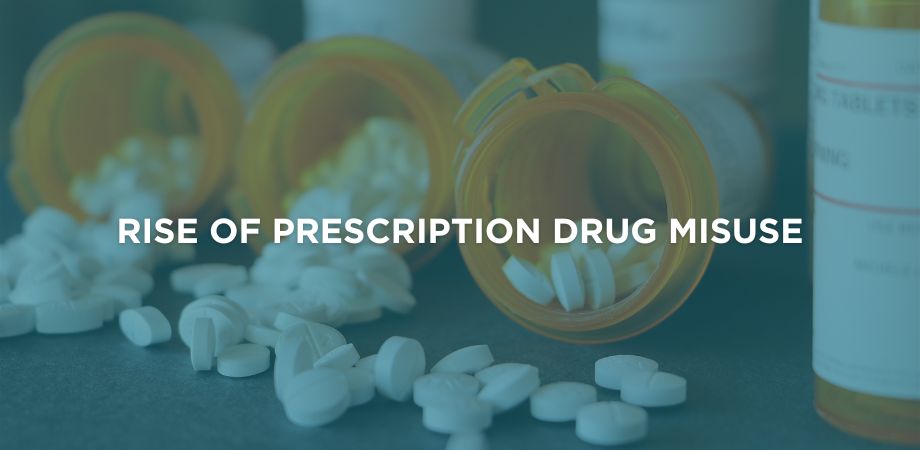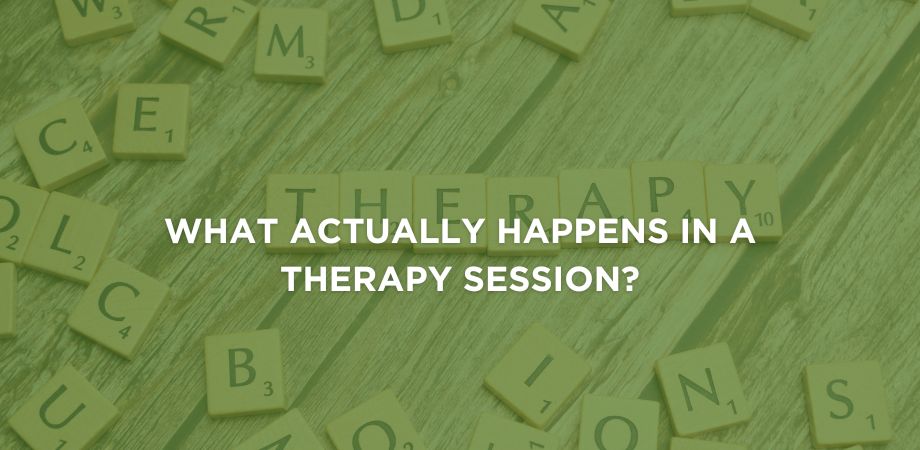Alcohol detox is the first and most critical step in recovering from alcohol dependence, involving the body’s natural process of eliminating alcohol while managing the withdrawal symptoms that arise once drinking stops.
According to the National Family Health Survey-5 (NFHS-5) in India, 22.9% of men and 0.75% of women report alcohol use. About 19% of current users consume alcohol in a dependent manner, with high rates of heavy episodic drinking (43%) among current users.
The process of alcohol detox transpires in three main stages: early withdrawal, peak withdrawal, and late withdrawal. Each stage brings different challenges, from mild anxiety and nausea to more severe symptoms like seizures or delirium tremens.
Medications such as benzodiazepines (diazepam, lorazepam) and naltrexone are prescribed to lessen withdrawal symptoms, prevent complications, and lower relapse risks.
Side effects span physical (nausea, tremors, sweating, headache, increased heart rate) and mental (anxiety, depression, irritability, insomnia), with intensity shaped by drinking history and health.
The timeline of alcohol detox falls between a few days and a week, although lingering cravings and emotional symptoms persist longer.
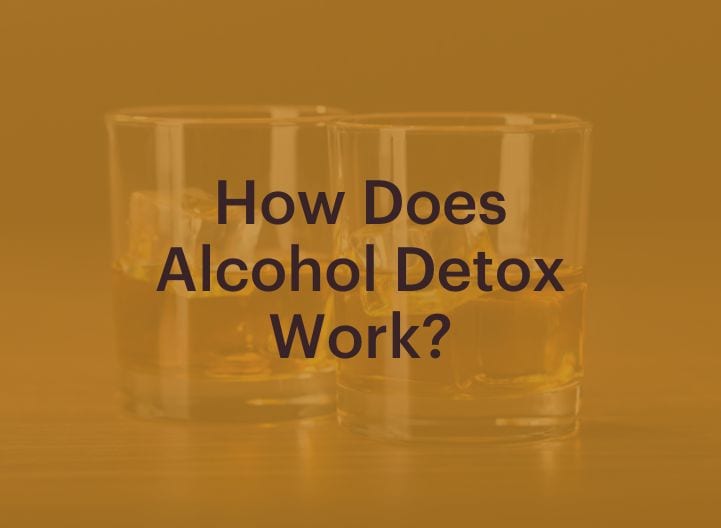
What Is Alcohol Detox?
Alcohol detox is the process by which the body eliminates alcohol from its system after prolonged or heavy use, triggering withdrawal symptoms such as nausea, sweating, tremors, anxiety, and, in severe cases, seizures or delirium tremens.
This stage cleanses the body, safely managing withdrawal under medical supervision. Detox serves as the foundational cornerstone in de-addiction treatment, preparing individuals physically and mentally for rehabilitation and long-term recovery.
The Government of India supports treatment through the National Action Plan for Drug Demand Reduction (NAPDDR), which funds over 350 Integrated Rehabilitation Centres for Addicts (IRCAs), District De-addiction Centres (DDACs), and Addiction Treatment Facilities (ATFs), providing counselling, detoxification, and pharmacotherapy.
How Does Alcohol Detox Work?
Alcohol detox works by allowing the liver to metabolise and gradually clear alcohol from the bloodstream. Naturally, the liver breaks down alcohol into less harmful substances, but when drinking stops after prolonged use, the body reacts to the sudden absence of alcohol, leading to withdrawal symptoms as the brain and nervous system struggle to rebalance. During this process, healthcare providers monitor vital signs, manage symptoms, and sometimes prescribe medications to minimise risks, ensuring detox is as safe and stable as possible.
Per capita alcohol consumption in India was 5.7 litres per person aged above 15 in 2016 and has been rising steadily across states, reflecting increased alcohol use and addiction risks, as published by Umesh N. and Olickal J. 2023 in “Prevalence, Associated Factors, and Reasons for the Initiation of Alcohol Use Among Female College Students During the COVID-19 Pandemic: A Mixed-Methods Study from Urban Bengaluru, India.”
Who Needs Alcohol Detox?
Alcohol detox is needed by individuals whose drinking patterns put them at risk of withdrawal or cause serious health concerns. Alcohol detox is most beneficial for individuals who:
- Depend on alcohol daily: Those with alcohol dependence struggle to stop drinking without withdrawal.
- Engage in binge drinking: People who consume excessive amounts of alcohol in short periods develop sudden withdrawal symptoms.
- Show signs of withdrawal risk: Individuals experiencing tremors, sweating, or anxiety when not drinking.
- Have co-occurring health issues: Those with conditions such as liver disease or cardiovascular problems that alcohol worsens.
- Are at risk of severe withdrawal complications: People with a history of seizures, delirium tremens, or previous failed detox attempts.
What Are the Stages of Alcohol Detox?
The stages of alcohol detox progress in a predictable timeline, though severity varies per individual, and are indicated as follows:
Stage 1: Early Withdrawal
During the first 6-12 hours after the last drink, mild symptoms begin to surface. These are often uncomfortable but manageable with medical support.
Early withdrawal symptoms comprise:
- Anxiety
- Headaches
- Nausea
- Sweating
- Irritability
Stage 2: Peak Withdrawal
This stage happens between 24-72 hours after the last drink and is the most dangerous. Withdrawal symptoms reach their peak intensity, requiring close medical supervision.
Peak withdrawal symptoms consist of:
- Seizures
- Tremors
- High blood pressure
- Rapid heartbeat
- Fever
- Hallucinations
- Risk of delirium tremens (DTs), a life-threatening complication
Stage 3: Late Withdrawal
Late withdrawal symptoms, such as anxiety and cravings, persist for up to a week after the last drink. These are psychological in nature but linger beyond the physical detox stage.
Late withdrawal symptoms are:
- Mood swings
- Fatigue
- Cravings
- Sleep disturbances
- Lingering anxiety
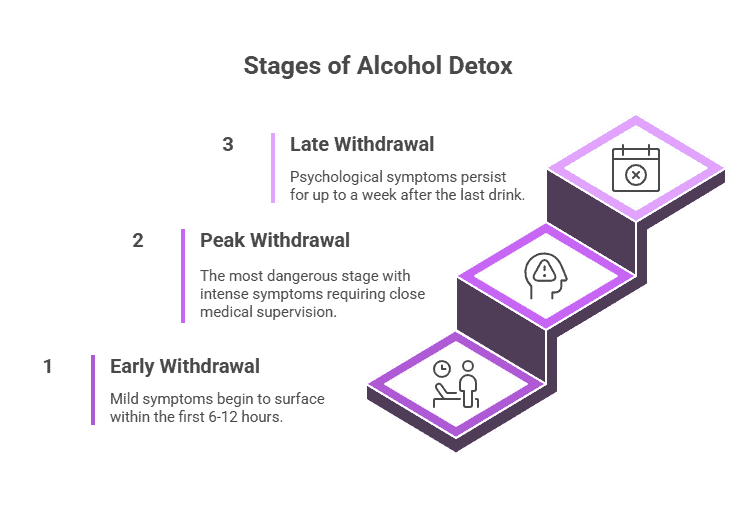
What Is the Hardest Day of Alcohol Detox?
Day 2 of alcohol detox is the hardest day of alcohol detox because withdrawal symptoms peak during this time. Seizures, tremors, and hallucinations are most likely to materialise, necessitating urgent medical care for safety.
What Are the Different Types of Alcohol Detox?
The different types of alcohol detox that provide varying levels of care depending on the severity of withdrawal risk and personal needs are medical detox (inpatient), outpatient detox, and social/supportive detox.
1. Medical Detox (Inpatient)
Medical detox takes place in a supervised rehab facility with 24/7 medical support. It is best for people with severe withdrawal symptoms or high seizure risk. Doctors monitor vital signs, prescribe medications, and intervene in case of emergencies.
2. Outpatient Detox
Outpatient detox allows individuals with mild withdrawal symptoms to detox at home while receiving medical monitoring through regular check-ins. This option provides flexibility but requires a stable support system at home.
3. Social/Supportive Detox
Social detox is a non-medical detox program that focuses on peer support and emotional care. While not suitable for those at risk of severe withdrawal, it aids people with milder dependence in managing cravings and psychological symptoms in a structured, supportive setting.
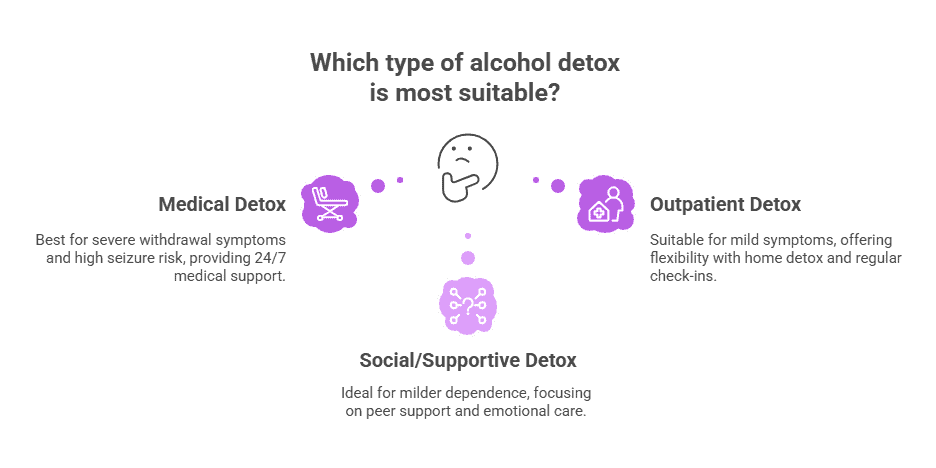
Is It Safe to Detox from Alcohol at Home?
No, it is not safe to detox from alcohol at home due to withdrawal severity and seizure risk. Although mild withdrawal is sometimes managed without medical supervision, heavy drinkers face a significant danger of life-threatening complications such as delirium tremens. Roughly 3-5% of patients with alcohol withdrawal syndrome progress to delirium tremens, the most severe form of withdrawal, which is fatal if untreated, as noted by Schuckit M. 2014 in “Recognition and Management of Withdrawal Delirium (delirium tremens).” Seizures eventuate in about 3-5% of cases within 12 to 48 hours after cessation.
For this reason, medical assistance is strongly advised for anyone with alcohol dependence, especially those with a history of binge drinking or prior withdrawal complications.
What Medications Are Used for Alcohol Detox?
Medications used in alcohol detox help manage withdrawal symptoms, mitigate seizure risk, and support long-term recovery. Commonly prescribed options include:
- Benzodiazepines: These are the most frequently used drugs in alcohol detox, prescribed in up to 80% of inpatient detox programs. They calm the nervous system, curb anxiety, and lower the chance of seizures.
A study in India reported that benzodiazepines such as lorazepam, diazepam, and chlordiazepoxide are commonly prescribed for alcohol detox, with lorazepam being the most frequently used (61.36%), as detailed by Vadakkan et al. 2022 in “Clinical Utility of Benzodiazepine in the Management of Alcohol Withdrawal Syndrome in a Tertiary Care Teaching Hospital.” - Diazepam: A long-acting benzodiazepine that offers steady relief during withdrawal. It is effective in curtailing severe symptoms like seizures and delirium tremens.
- Lorazepam: A shorter-acting benzodiazepine used in patients with liver impairment, providing safe and reliable symptom control.
- Naltrexone: A Central Drugs Standard Control Organisation (CDSCO)-approved medication that blocks the rewarding effects of alcohol. While not used for acute withdrawal, it is prescribed after detox to maintain abstinence. Studies show it reduces relapse rates by up to 36%, as explored by Streeton C. and Whelan G. 2001 in “Naltrexone, a Relapse Prevention Maintenance Treatment of Alcohol Dependence: a Meta-analysis of Randomised Controlled Trials.”
What Are the Side Effects of Alcohol Detox?
The side effects of alcohol detox are physical and mental, arising as the body adjusts to the absence of alcohol. Physical symptoms are sweating, nausea, vomiting, headaches, tremors, and rapid heartbeat, while mental symptoms are anxiety, depression, irritability, and difficulty concentrating. In some cases, more severe reactions such as confusion, hallucinations, or seizures ensue, reflecting higher withdrawal severity. The intensity and duration of these side effects differ conditional on the individual’s history of alcohol use, overall health, and presence of alcohol dependence, making close monitoring and professional support vital during detox.
What Is the Typical Timeline for Alcohol Detox?
The typical timeline for alcohol detox follows several stages, beginning within hours of the last drink and progressing over several days. The typical timeline for alcohol detox is highlighted below:
1. 6-12 hours: Early withdrawal begins with anxiety, headaches, and nausea.
2. Day 1: Symptoms intensify; sleep issues, tremors, and sweating develop.
3. Day 2: The hardest day; seizures, hallucinations, and peak symptoms arise.
4. Day 3-4: Symptoms gradually decrease, though mood swings and cravings continue.
5. Day 5-7: Most physical symptoms resolve, leaving behind psychological cravings.



